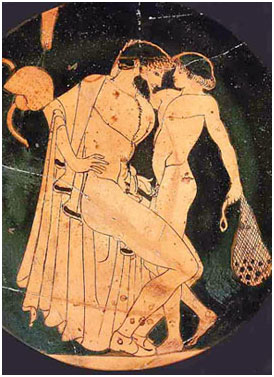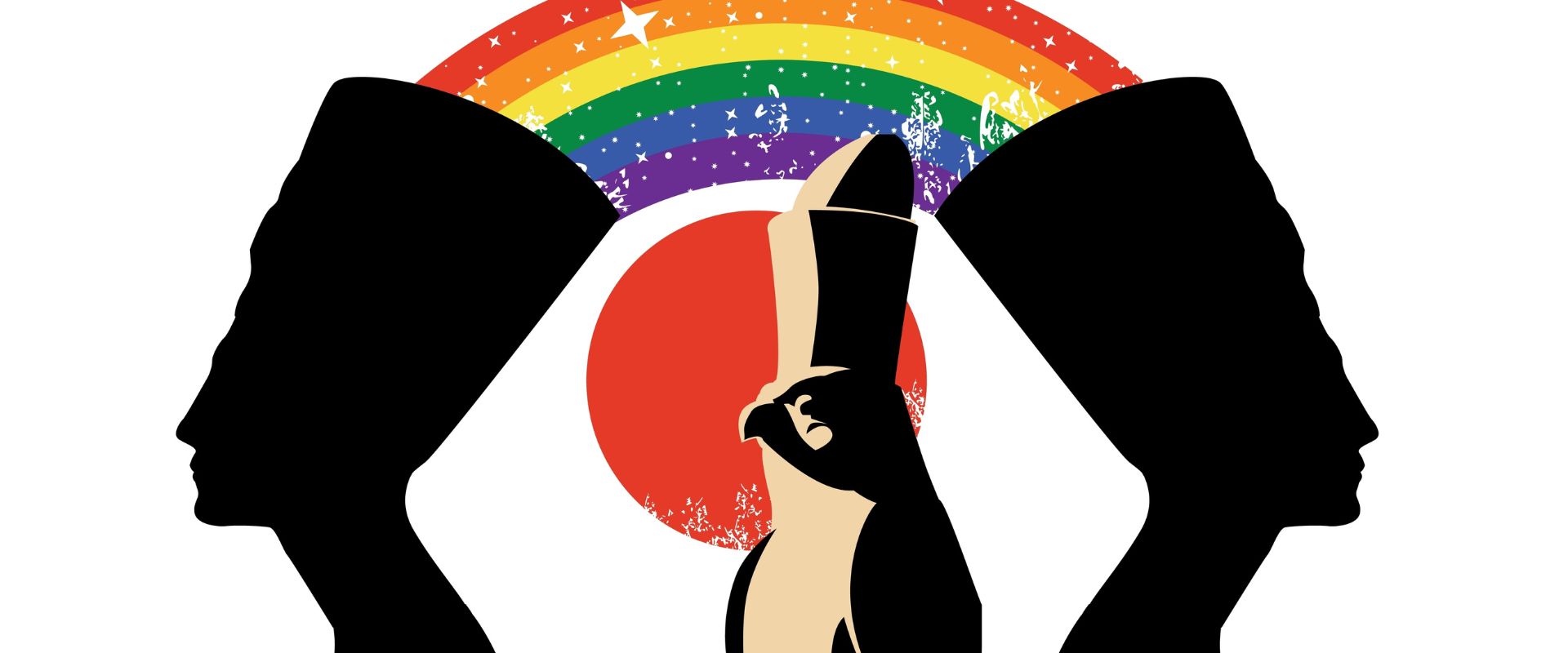What is the history of homosexuality? Let’s take a gay history trip through time. Before 1886, society had no real terminology to describe the relationship between same sex individuals. Indeed, the term Homosexuality was coined by Richard Von Krafft-Ebing in his widely published book ‘PsychopathiaSexualis‘. Since then, the dichotomy of homosexuality, and subsequently heterosexuality, have become mainstream terminology to describe same sex attraction and sexual orientation.
Before this time, same sex relationships instead relied on cultural terminology to define the relationship. It was categorised by a different set of values regarding the philosophy of love.
Throughout the course of history, time and across cultures, social attitudes towards same sex relationships have varied. Same sex relationships have been considered an expectation that all males would at some point in their youth engage in a same sex relationship. To the idea of casual integration to acceptance, to seeing homosexuality as being considered a sin. Repressing same sex relationships through legislation and judicial mechanisms inclusive of the punishment of death for practicing homosexuality.
History of Homosexuality
How Old Is Homosexuality?
From modern research, and through the study of ancient texts, artworks and social practices, we have now come to the conclusion that homosexuality is considered to be ubiquitous across the globe.
It has existed over the course of time, and throughout most cultures in human history regardless of whether or not it was tolerated. Only factor that has changed with regards to homosexuality in human history is through the degree of openness through which it is practiced.
In 1948, Alfred Kinsey, published the article ‘Sexual Behaviours in the Human Male’. This is now commonly referred to as the Kinsey reports. In these reports, Kinsey developed the Kinsey scale.
What is the Kinsey Scale?
Also called the Heterosexual–Homosexual Rating Scale, which is used to argue that the previously thought exclusive dichotomy of Heterosexual and Homosexual could not exist. Rather, that human sexuality existed on this scale with 0 being representative of exclusively heterosexual. 7 as exclusively homosexual. And a person’s position on this scale would change throughout various stages of their life.
This was representative of their passion which would ebb and flow throughout the course of their lives. Sometimes their passion levels would be non-existent. Other times they’d be sky-rocketing.
The Kinsey Scale supports the ebb and flow of human sexuality and same sex relationships over the course of human history.
It is often argued, within modern society and particularly through homophobic religious groups, that the idea of homosexuality only exists in modern times. And that is a representation of the moral decline of the world. This article will debunk that myth through the exploration of same sex relationships through varying cultures. And the degrees to which it was practiced and understood.

Ancient Cultures (Greeks and Romans)
Same sex relationships existed in most ancient cultures.
We have determined this through archaeological anthropologists who have dedicated their research to the study of same sex relationships in human history. Through their research, we have since determined that the Ancient Greeks and Romans were known to engage in consensual homosexual contact. These relationships were not only tolerated social practices. But also celebrated through entertainment, arts, and cultural events and activities.
Male youth in these cultures were often encouraged to take on the role of being passive to older counterparts in mentoring roles.
Often, these mentoring roles would involve a short term sexual relationship.
These relationships were a form of intergenerational male love and regarded as a social duty.
Greek word for a relationship between a man and a youth was paiderastia Origination of the term pederasty. It was derived from the words pais (Boy) and Eran (Love). These relationships were considered to be harmless so long as both people were consensual. Only factors that inhibited these relationships were age factors and relative status (incestuous relationships were not allowed).
Ancient Greeks believed that homosexual love should be seen as a complementing factor to marriage. Though homosexual relations were encouraged before marriage, they were generally tolerated throughout the marriage as well.
In the end the idea that a man could be attracted to both women, and beardless boys was considered to be a natural occurrence. It was exemplified through stories of mythology and Greek Heroes. A simple search on Greek heroes/gods and their homosexual lovers will reveal countless stories enshrined within mythology.

Ancient Romans or Greeks did not have any concept of homosexuality, and heterosexuality.
You can determine this through an examination through these cultures important artworks which showed a mainstream depiction of life. It was not an alternative art form or lifestyle.
Was just assumed that people would be attracted to both men and women. Any deviation from this concept would often be considered as an eccentricity. It’s also important to note that as both societies were considered to be patriarchal. An important aspect in homosexual relationships was the status and age of the individual who would assume the ‘active’ role of penetration.
This raises a lot of questions as to when age differing relations was considered to be immoral. Or as deviating from societal acceptance. It is something that we will certainly explore in another article.
Same sex relations were not just limited to the Ancient Romans and Greeks
They have also been found in a myriad of other cultures across the globe.
Indeed, same sex relations were also prevalent in African cultures. Though it should be noted that the perspectives on African Culture are primarily driven through European views from within the medieval periods. Between the years 1591-1593 a document titled ‘Denunciations of Bahia‘ specifically refers to a slave culture. Where a cobblers slave was well known to be a sodomite and for ‘performing the duties of a female’.
This document pays particular attention to the custom of pagan ‘Negros’ who would wear clothing to cover the male genitals. But which would leave an opening for the rear for people to serve as passive women and engage in same sex acts.
Zimbabwe has been subjected to horrific anti-homosexual legislation. There have been rock paintings by the San people which recorded anal sexual activity between men that has been dated back to thousands of years.
Native American Same Sex Relations
Same sex relations and the diversity of sexual relations have also been described among Native American peoples through the term ‘two spirit’. Though the use of this term is sometimes deemed to be offensive to Native Americans.
Men who identified as ‘Two spirit’ would wear women’s clothing. And were revered among their peers as being spiritually gifted and as a gift of god. Deemed to have special insight into the world of spiritual matters and were seen as advisors to their peers.
It is clear that throughout history, same sex relationships have existed across cultures in varying degrees and forms. It’s difficult to prescribe them as being homosexual relationships. Homosexual is a term that has been prescribed as a retroactive term. Many of these cultures did not understand, or prescribe to the concept of heterosexuality. The only real way of defining these relationships is to define them as being same sex relationships.
So what changed?
Defining Gay Rights – Legislation and Implicit Rights
Progression of Lesbian, Gay, Bisexual, Transgender and Queer (LGBTQ+) rights globally has been a rollercoaster ride, with many highs and lows. This article takes a deep dive into the ten most significant legal changes that have impacted the LGBTQ+ community. Reshaping the landscape for queer individuals worldwide.
1945: The Birth of United Nations and Implicit LGBTQ+ Rights
The foundation of the United Nations (UN) in 1945, following World War II, marked the beginning of a global movement towards universal human rights. Although there was no explicit mention of LGBTQ+ rights in the UN Charter. The principle of non-discrimination based on ‘sex’ laid down in the Charter was later interpreted by activists and legal scholars to include sexual orientation and gender identity.
While the UN’s inception marked a new era of international cooperation on human rights. LGBTQI+ rights remained largely unspoken of until the late 20th century. It was not until the 1994 Toonen v. Australia case that the UN Human Rights Committee recognized discrimination based on sexual orientation as a violation of international human rights law.
1989: Price Waterhouse v. Hopkins – An Accidental LGBTQ+ Precedent
The landmark US Supreme Court case, Price Waterhouse v. Hopkins in 1989, although not directly related to LGBTQ+ rights, paved the way for future legal victories for the community. The court ruled that “sex stereotyping” constitutes discrimination under Title VII of the Civil Rights Act of 1964. A move that indirectly benefited transgender and gender nonconforming individuals.
In the years following the Price Waterhouse case, federal courts began to apply the sex stereotyping theory to protect transgender individuals. The Price Waterhouse precedent has since been instrumental in numerous LGBTQ+ rights cases. Contributing significantly to the progression of LGBTQ+ rights in the country.
2000: The Yogyakarta Principles – An International Breakthrough
In 2007, a group of independent experts met in Yogyakarta, Indonesia, to articulate a clear framework for international human rights standards related to sexual orientation and gender identity. Resulting Yogyakarta Principles have since served as a touchstone for LGBTQ+ rights globally.
The Yogyakarta Principles have played a crucial role in guiding countries towards implementing laws and policies that respect and protect the rights of LGBTQ+ individuals. They have been instrumental in pushing for the decriminalization of same-sex activity. Protection from violence and discrimination, and recognition of same-sex relationships.
2003: Overturning of Sodomy Laws in the United States
The Supreme Court ruling in Lawrence v. Texas in 2003 invalidated sodomy laws in 14 states, effectively decriminalizing same-sex relations across the United States. This decision marked a significant step forward in the fight for LGBTQ+ rights.
Despite the landmark ruling, several states have yet to repeal their sodomy laws. While these laws are unenforceable, their existence perpetuates stigma and discrimination against the LGBTQ+ community.
2008: UN Statement on LGBTQ+ Rights
In 2008, a group of 66 countries issued a statement before the UN General Assembly affirming their support for LGBTQ+ rights, grounding their argument in the Universal Declaration of Human Rights. This statement marked the first collective international effort to recognize LGBTQ+ rights.
This statement faced opposition from several countries, including Russia, China, and the United States under the Bush administration. Despite the pushback, the 2008 statement paved the way for further advancements in LGBTQ+ rights at the global level.
2011: “Gay Rights Are Human Rights”
In 2011, then-US Secretary of State Hillary Clinton made a historic declaration before the UN Human Rights Council, stating that “gay rights are human rights“. This affirmation signaled a shift in US foreign policy towards a more proactive stance on LGBTQ+ rights.
Clinton’s declaration ushered in a period of active promotion of LGBTQ+ rights in US foreign policy. But it also sparked backlash from conservative groups both domestically and internationally, highlighting the divisive nature of the issue.
2013: Legalization of Gay Marriage in the US
In 2013, the US Supreme Court struck down the Defense of Marriage Act, effectively legalizing same-sex marriage nationwide. This historic ruling was a major victory for the LGBTQ+ rights movement and marked a turning point in the fight for LGBTQ+ equality.
The Supreme Court’s decision had far-reaching implications, inspiring other countries to follow suit. Today, same-sex marriage is recognized in 29 countries worldwide.
2016: Appointment of the UN Independent Expert on Sexual Orientation and Gender Identity
In 2016, the UN Human Rights Council appointed Vitit Muntarbhorn. As the first Independent Expert on protection against violence and discrimination based on sexual orientation and gender identity. This appointment represented a significant step towards the institutionalization of LGBTQ+ rights within the UN system.
Despite this progress, the appointment faced resistance from several UN member states, reflecting the ongoing controversy surrounding LGBTQ+ rights at the international level.
2018: India Decriminalizes Homosexuality
In 2018, India’s Supreme Court struck down a colonial-era law criminalizing homosexuality, marking a major milestone for LGBTQ+ rights in the world’s second most populous country. This ruling had a ripple effect across the region, inspiring activists in other Asian countries to challenge similar laws.
2019: Taiwan Legalizes Same-Sex Marriage
In 2019, Taiwan became the first country in Asia to legalize same-sex marriage, setting a precedent for LGBTQ+ rights in the region.
The Road Ahead
Despite these landmark developments, the fight for LGBTQ+ rights is far from over. LGBTQ+ individuals continue to face discrimination and violence in many parts of the world. Our global legal landscape remains a patchwork of progressive and regressive laws that affect the queer community.
As we look to the future, it’s clear that the struggle for LGBTQ+ rights will continue to evolve. Shaped by local contexts, global trends, and the tireless efforts of activists worldwide. The ten laws discussed in this article are not an exhaustive list. But they represent significant milestones in the ongoing journey towards LGBTQ+ equality.
Challenges Of Coming Out

Coming Out As A Mature Gay




You must be logged in to post a comment.